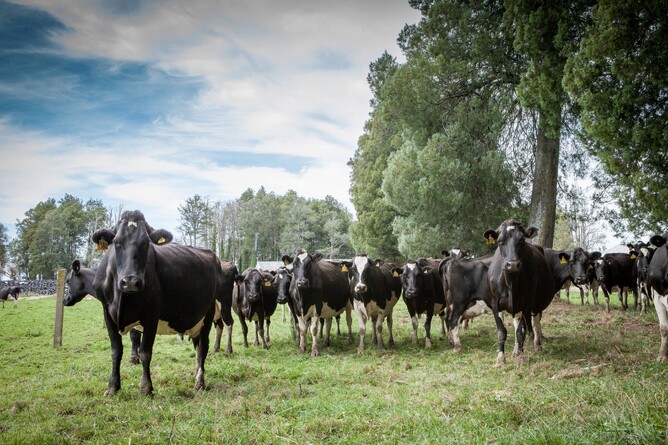20-30% of global emissions come from agricultural emissions. New Zealand's contribution to global emissions is 0.16%, and of that 0.08% comes from our agricultural activities. While many view this figure as a negative, it's not painting the whole picture.
When looking at these figures, it's important to look at them from a global perspective and a per kilogram of product and nutritional perspective.
Milk, for instance, punches above its weight in terms of the nutrients it provides and plays an extremely important role in global nutrition. New Zealand has long been recognised as one of the most efficient countries in the world in producing milk and red meat, contributing a much lower carbon footprint per kilogram of product than other countries.
But that's not to say we can't and shouldn't take steps to improve our emissions. While the emissions associated with milk production on a per litre basis have been decreasing by around 1% a year, much work is being done locally to further reduce emissions. More can and should be done.
But how do we decrease emissions but remain on track to feed the estimated 10 billion people by 2050?
While many would call for milk to be completely taken out the system for the environmental benefits alone, modelling shows that on a global basis, the practicality of doing so isn't there. Milk would need to be replaced in the system with another product (or products) of a similar nutritional value. These products have their own emissions generated, and if it took multiple products to fill the gap of milk, the net effect could in fact be that emissions increase.
In short, there is no silver bullet. Success in this space will be the result of large and small efforts both locally and internationally, where effective, scalable solutions will be key. When we look at methane, New Zealand has a small proportion of the world's ruminants, so any local changes we make to our methane emissions, while still incredibly important and all add up, aren't going to have a huge impact on global methane emissions.
Coming up with technical solutions that can be used and benchmarked here and then utilised in countries with larger ruminant populations can make a much bigger impact. A great example of this is our low methane sheep and our ongoing work in the space of supplements to reduce methane, such as Kowbucha, a fermentation-based solution being developed by Fonterra.
These solutions must be looked at in the context of some key areas. Namely, they have to be scalable.
They should also meet the '4 goods':
- Be good for the product (no contaminants, maintaining nutritional product profile, etc.)
- Be good for the health and performance of the animal
- Be good for the farmer, both economically and practically
- Be good for the planet, which means having good science to back it up.
This is where agtech can and IS playing an important role. We have been seeing innovation come through for some time now that is helping to reduce emissions and help farmers transition into operating their businesses in this new environment.
Technology cannot be developed in a vacuum. Agtech can create tools to reduce GHG emissions, but technology has to work closely with farmers, making sure it does not disrupt current practices but rather provide them with tools and capabilities to enable them to reduce GHG emissions and reduce their impact on the planet. A variety of technology is being deployed – from AI to support commercial and environmental decisions, to farm devices and animal wearables that monitor emissions in the field and reduce them on the spot. Sprout, as an agri and foodtech specialist, provides not only capital but also capabilities and connections to help bridge the gap between the labs and the field.
When considering the discussion around GHG, it's easy to get stuck in focusing on emissions and not looking at the whole picture of where and how our food is produced. While reducing GHG is imperative, doing so at the expense of the health of our ecosystems, waterways, and other biological components of our land is not. Often doing good for one does good for the other, but this isn't always the case. It highlights the importance of rethinking how we choose to utilise our resources.
The same thinking should be applied when thinking about food packaging. While outwardly it seems that less packing equates to a lower carbon footprint, that's not always the case. For some foodstuffs, less packaging can have a negative effect on the product leading to food waste and ultimately a negative effect on carbon footprint, with food waste being another big focal point in the emissions conversation.
Another big part of the picture is looking at land use diversification and collating useful data that supports farmers in those decisions. It is also looking at what else we can efficiently produce. In New Zealand, we often think first of our land-based protein options, but there could be other opportunities. An example of this is open ocean aquaculture. Shellfish farmed in NZ have a lower carbon footprint than all other animal-derived protein sources, including farmed fish and are most closely comparable to the carbon footprint of tofu per kilogram of protein.
The solution for reducing emissions won't be simple or easy. It will require all parts of our primary sector to adapt and be willing to make changes and collaborate with the rest of the world. It will require regulation and legislation to support the technical solutions we need as well as funding to bring them to life.
Note: Thank you to Barbara Nebel, CEO of thinkstep-anzand Jeremy Hill, Chief Science and Technology Officer at Fonterra who lent us their expertise and commentary to put this blog together.

